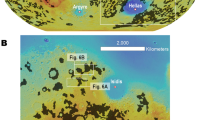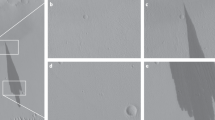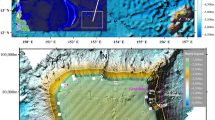Abstract
One of the surprises of the NEAR-Shoemaker mission was that Eros's surface exhibits a wide variety of landforms, which are indicative of a global covering of loose fragmental debris1. At one extreme in roughness is the Shoemaker Regio area, which is characterized by a high density of boulders up to 100 m across, slumps, slides, and finer blanketing material. At the other extreme are distinctive, flat deposits that appear smooth down to a resolution of 1.2 cm per pixel. Here we report the results of global mapping and colour analysis of these smooth deposits. They have formed most efficiently in restricted areas, and appear to be the result of deposition of finer material sorted from the upper portion of the asteroid's regolith. The smooth deposits constitute a family of features with a range of morphologies, but all appear to be the result of sedimentation. The geography of the deposits is consistent with some predicted aspects of photoelectric sorting, but these exotic transport and depositional mechanisms are not well understood. Deposits with the properties seen on Eros have no obvious analogues in previous lunar or asteroid data.
This is a preview of subscription content, access via your institution
Access options
Subscribe to this journal
Receive 51 print issues and online access
$199.00 per year
only $3.90 per issue
Buy this article
- Purchase on Springer Link
- Instant access to full article PDF
Prices may be subject to local taxes which are calculated during checkout




Similar content being viewed by others
References
Veverka, J. et al. Imaging of small-scale features on 433 Eros from NEAR: Evidence for a complex regolith. Science 292, 484–488 (2001).
Cheng, A. F. et al. Laser altimetry of small-scale features on 433 Eros from NEAR-Shoemaker. Science 292, 488–491 (2001).
Thomas, P. C. et al. Eros: Shape, topography and slope processes. Icarus (in the press).
Veverka, J. et al. The landing of the NEAR-Shoemaker spacecraft on asteroid 433 Eros. Nature 413, 390–393 (2001).
Bell, J. F. III et al. Near-IR reflectance spectroscopy of 433 Eros from the NIS instrument on the NEAR mission. 1. Low-phase angle observations. Icarus (in the press).
Murchie, S. et al. Color variations on Eros from NEAR multispectral imaging. Icarus (in the press).
Clark, B. E. et al. NEAR infrared spectrometer photometry of asteroid 433 Eros. Icarus (in the press).
McCord, T. B. & Johnson, T. V. Lunar spectral reflectivity (0.30 to 2.50 microns) and implications for remote mineralogical analysis. Science 169, 855–858 (1970).
McCord, T. B. & Adams, J. B. Progress in remote optical analysis of lunar surface composition. Moon 7, 453–474 (1973).
Hapke, B. Space weathering from Mercury to the asteroid belt. J. Geophys. Res. 106, 10039–10073 (2001).
Pieters, C. M. et al. Space weathering on airless bodies: Resolving a mystery with lunar samples. Meteor. Planet Sci. 35, 1101–1107 (2000).
Matson, D. L., Johnson, T. V. & Veeder, G. J. Soil maturity and planetary regoliths: the Moon, Mercury, and the asteroids. Proc. Lunar Sci. Conf. 8, 1001–1011 (1977).
Adams, J. B & Felice, A. L. Spectral reflectance 0.4 to 2.0 microns of silicate rock powders. J. Geophys. Res. 72, 5705–5715 (1967).
Lee, P. Dust levitation on asteroids. Icarus 124, 181–194 (1996).
Duennebier, F. K. & Sutton, G. H. Thermal moonquakes. J. Geophys. Res. 79, 4351–4363 (1974).
Lee, P. C. Physical Properties and Processing of Asteroid Regoliths and Interiors. Thesis, Cornell Univ. (1977).
Thomas, P. C., Veverka, J., Robinson, M. S. & Murchie, S. Shoemaker crater as the source of most ejecta blocks on the asteroid 433 Eros. Nature 413, 394–396 (2001).
Criswell, D. R. in Photon and Particle Interactions with Surfaces in Space (ed. Grard, R. J. L.) 545–556 (Reidel, Dordrecht, 1973).
Acknowledgements
We thank the mission design, mission operations, and spacecraft teams of the NEAR Project at the Applied Physics Laboratory of Johns Hopkins University and the navigation team at the Jet Propulsion Laboratory for their efforts that resulted in making NEAR Shoemaker the first spacecraft to orbit and land on an asteroid. The NEAR-Shoemaker mission and this work were made possible by NASA. We thank A. Rivkin and M. Cintala for suggestions.
Author information
Authors and Affiliations
Corresponding author
Rights and permissions
About this article
Cite this article
Robinson, M., Thomas, P., Veverka, J. et al. The nature of ponded deposits on Eros. Nature 413, 396–400 (2001). https://doi.org/10.1038/35096518
Received:
Accepted:
Issue Date:
DOI: https://doi.org/10.1038/35096518
This article is cited by
-
Distribution of water phase near the poles of the Moon from gravity aspects
Scientific Reports (2022)
-
Fine-grained regolith loss on sub-km asteroids
Nature Astronomy (2022)
-
Determining the Relative Cratering Ages of Regions of Psyche’s Surface
Space Science Reviews (2022)
-
Assessing the Sampleability of Bennu’s Surface for the OSIRIS-REx Asteroid Sample Return Mission
Space Science Reviews (2022)
-
Surface environment of Phobos and Phobos simulant UTPS
Earth, Planets and Space (2021)
Comments
By submitting a comment you agree to abide by our Terms and Community Guidelines. If you find something abusive or that does not comply with our terms or guidelines please flag it as inappropriate.



